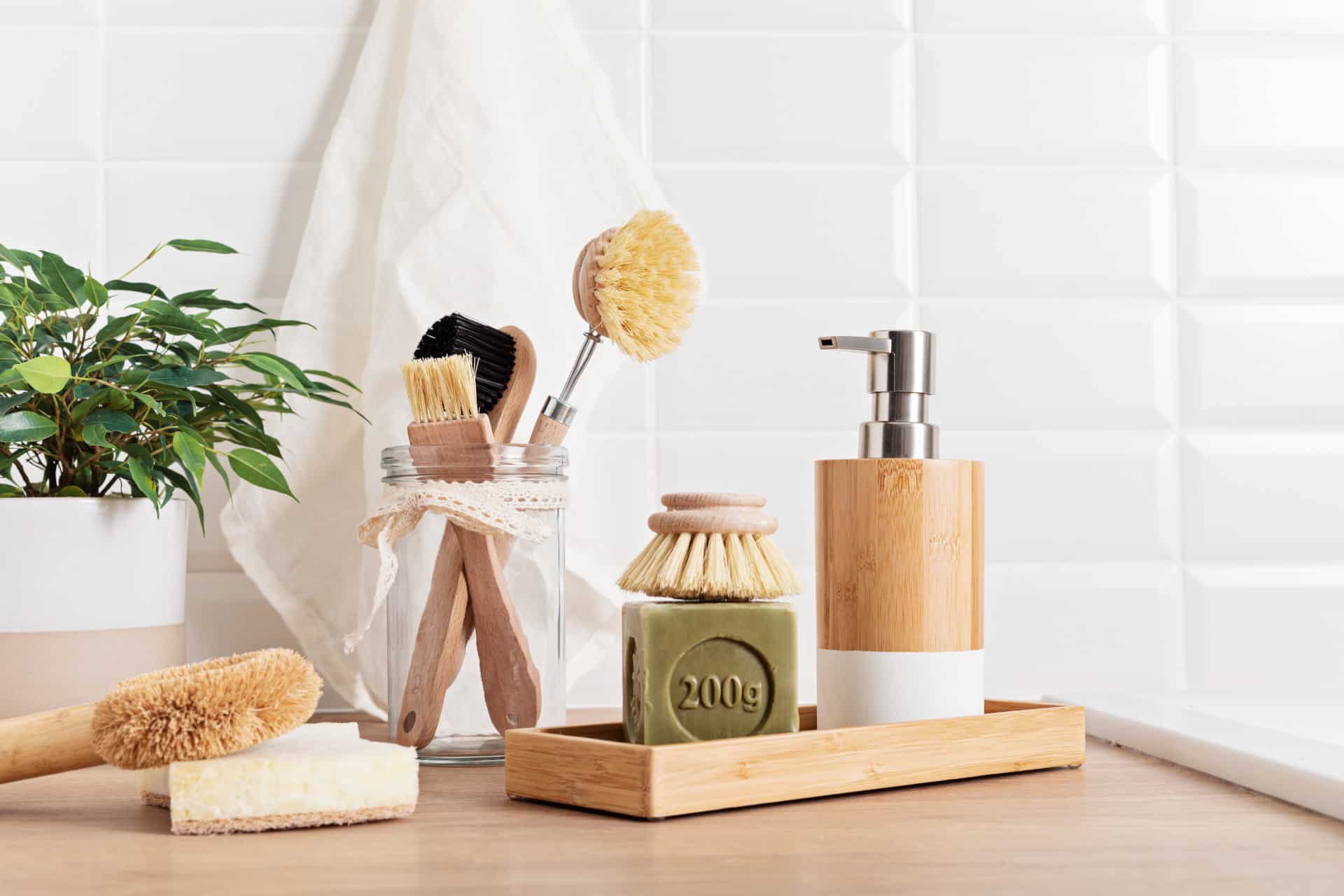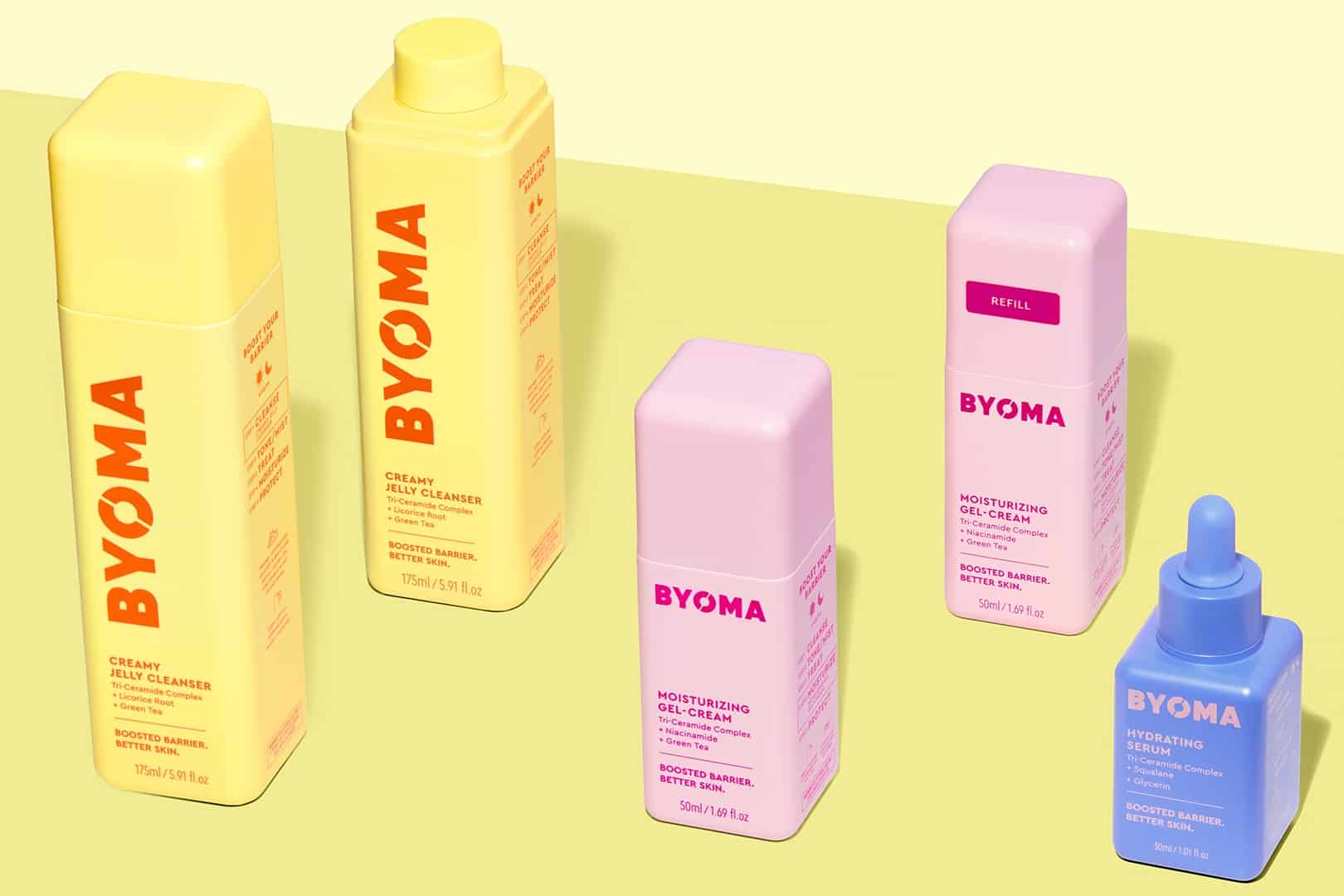The Best Non-Toxic Cutting Board For a Conscious Kitchen (2022)

Cutting boards might seem innocent, but we found many shocking reasons why a cutting board could be a safety concern in our research.
From potentially unsafe adhesives that could release formaldehyde to plastic cutting boards that could contain toxic ingredients, it’s essential to know what’s lurking inside that seemingly inconspicuous block of wood (or plastic) on your countertop.
So what’s the verdict? Are wooden cutting boards safer than plastic cutting boards? Are plastic cutting boards safe at all?
Let’s take a closer look at the world of cutting boards, and find out why purchasing a non-toxic cutting board might be in your best interest.
Rating Cutting Board Materials
There are several different materials used in cutting boards, and here’s how we rate them at Better Goods.
Plastic (Rating: Avoid)
We do not recommend plastic cutting boards. There are several reasons why:
- They degrade over time and can release harmful chemicals into your food.
- They can easily crack or scratch, making for small spaces where bacteria can live and grow.
- They may contain toxic anti-bacterial chemicals like triclosan, a possible endocrine disruptor. The USDA banned the sale of soaps containing triclosan, but it’s still found in some products. It’s also very toxic to aquatic life.
- Plastic cutting boards contain plasticizers like bisphenol A (BPA), a notorious chemical linked to several health problems. Plasticizers alter or imitate hormones and disrupt the body’s normal functions.
If you use a plastic cutting board, check it for deep cuts. If they’re there, we strongly recommend that you get rid of it. Ideally, you’ll replace it with a better non-toxic alternative.
Wood (Rating: Best)
Wooden cutting boards come in two types: hardwood and softwood. There are tradeoffs to each type.
Hardwood cutting boards are made from maple, walnut, oak, cherry, beach, and teak. They’re typically harder on your knives but don’t scar as easily as plastic or softwood cutting boards. Overall, hardwood cutting boards made from one solid block of wood are the best non-toxic cutting board.
Softwood cutting boards are made from wood like cedar or pine. They’re softer on your knives and can scar more easily.
Bamboo (Rating: Iffy)
Bamboo can be an excellent option for a non-toxic cutting board that’s also more eco-friendly. It’s rugged and durable yet lightweight and will last for a long time if taken care of. Bamboo cutting boards are also more sustainable than plastic or wooden cutting boards because bamboo is a grass that grows very quickly.
On the downside, bamboo cutting boards are harder than wooden cutting boards and will dull knives more quickly.
They’re also made from pieces of bamboo that are glued together with adhesives. These adhesives generally contain formaldehyde – an ingredient we strongly recommend avoiding.
Epicurean Wood (Rating: Avoid)
Epicurean wood cutting boards are often touted as a great eco-friendly alternative because they’re made from waste wood.
The problem with epicurean wood cutting boards is the same as bamboo: they’re made by gluing pieces of wood together with a resin that can release formaldehyde.
Glass (Rating: Iffy)
There are a lot of upsides to a glass cutting board. Glass is an inert material, meaning there are no worries of chemicals lurking inside, they’re low cost, and easy to clean.
On the downside, glass is a hard material and will dull knives quickly. They’re also very loud to use, which can be an issue in some homes if hearing the sound of chopping through the house is a concern. They’re also prone to breakage and will not tolerate being dropped.
Rubber (Rating: Good)
Natural tree latex can be used to make non-toxic cutting boards with many benefits.
- Because rubber is soft, it can protect your knives from becoming dull.
- Rubber is naturally non-slip, making it safer to use and preventing it from slipping around the table while chopping food.
- Unlike wood, rubber cutting boards will not absorb liquids, making them great for cutting meats.
The downside to rubber cutting boards is that they can quickly become damaged if care is not taken while using them since they’re a soft material.
End Grain vs. Edge Grain Cutting Boards
When it comes to wood cutting boards, there are two types: end grain and edge grain.
Edge Grain Cutting Boards
These are made from wood that has been cut with the grain. These cutting boards are less durable and cheaper than their end grain counterparts and will develop scars quickly.
The top of an edge grain cutting board will show long wood fibers. These fibers are more rigid and don’t have much give, so you’re chopping against the grain of the wood, making them dull knives more quickly and also hold scars more easily.
End Grain Cutting Boards
End grain cutting boards are the most durable and resist knife cuts more easily. The wood fibers in an end-grain cutting board are cut at an angle, so the blade meets the wood at many different points when you chop into it. This makes the end-grain cutting board less likely to scar and dull your knives.
On the other hand, end grain cutting boards are typically the most expensive type of cutting board because they’re more challenging to produce.
Safe Cutting Board Treatments
Cutting boards need to be seasoned to prevent them from warping, cracking, staining and absorbing odors.
Mineral Oil Coatings
Mineral oil coatings are a popular way to protect wooden cutting boards. The oil soaks into the wood, sealing it and making it water-resistant. It also helps to prevent the growth of bacteria.
Although food-grade mineral oil should be safe to use on a cutting board, but at Better Goods, we don’t recommend it for two reasons:
- Mineral oil is an unsustainable resource. It’s created from petroleum.
- Mineral oil is toxic to the environment and the people responsible for its production.
Beeswax Coatings
At Better Goods, we recommend using a beeswax coating as a safe and sustainable way to protect your wooden cutting board.
Food-grade beeswax is a safe alternative to mineral oil. It’s also an all-natural material that helps wood stay hydrated and makes it less prone to cracking and warping.
Beeswax coatings are a popular way to protect wooden cutting boards. The wax soaks into the wood, sealing it and making it water-resistant. It also helps to prevent the growth of bacteria.
Glues & Adhesives
A majority of bamboo or wooden cutting boards are made from pieces of wood glued together. While bamboo is an incredible renewable and non-toxic material, glues make it ideal for a good non-toxic cutting board.
The Safest Non-Toxic Cutting Board
To summarize the above, the safest non-toxic cutting board will be made from one solid block of wood, without any adhesives or mineral oil treatments.
This means that cheap boards are generally off the table because most cheap ones are made by gluing together smaller pieces of wood or bamboo.
Caring For Cutting Boards
To keep your cutting board safe and effective, here are some helpful tips you should always follow.
- Never put a wooden cutting board in the dishwasher. The extreme heat, water, and harsh detergents will ruin it, coming out of the machine warped.
- Don’t ever scrape a knife across a cutting board. Always use the side of the blade, as this will dull your knives faster.
- If you have a plastic or wooden cutting board that is deeply scratched or shows signs of wear, it may be time to replace it.
- If you have a glass cutting board, handle it with care. Don’t drop it, lay hot pots directly on the surface without protection, or put it in the dishwasher or microwave.
The Best Choices For Non-Toxic Cutting Boards
We researched and rounded up our choices for non-toxic cutting boards that cover different materials, price ranges, and use cases. Any of these cutting boards are a safe choice for any conscious and non-toxic kitchen.
Best End-Grain Board: Sonder Los Angeles
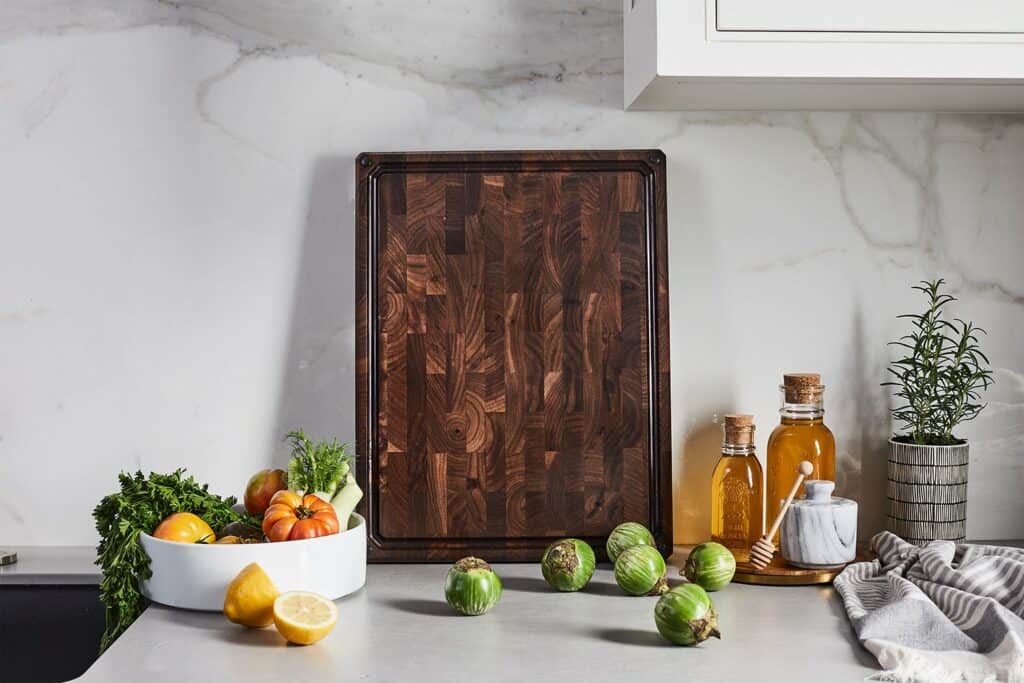
This solid end-grain walnut solid wood cutting board is one of the best non-toxic cutting boards out there. Made in the USA.
It features removable rubber feet on the bottom for stability, and the backside has three built-in compartments for food prep or serving.
At 1.5″ thick and a weight of 7.5 lbs, this is a heavy-duty cutting board that will last years with proper care.
Click here to see it on Amazon
Best Large Cutting Board: John Boos
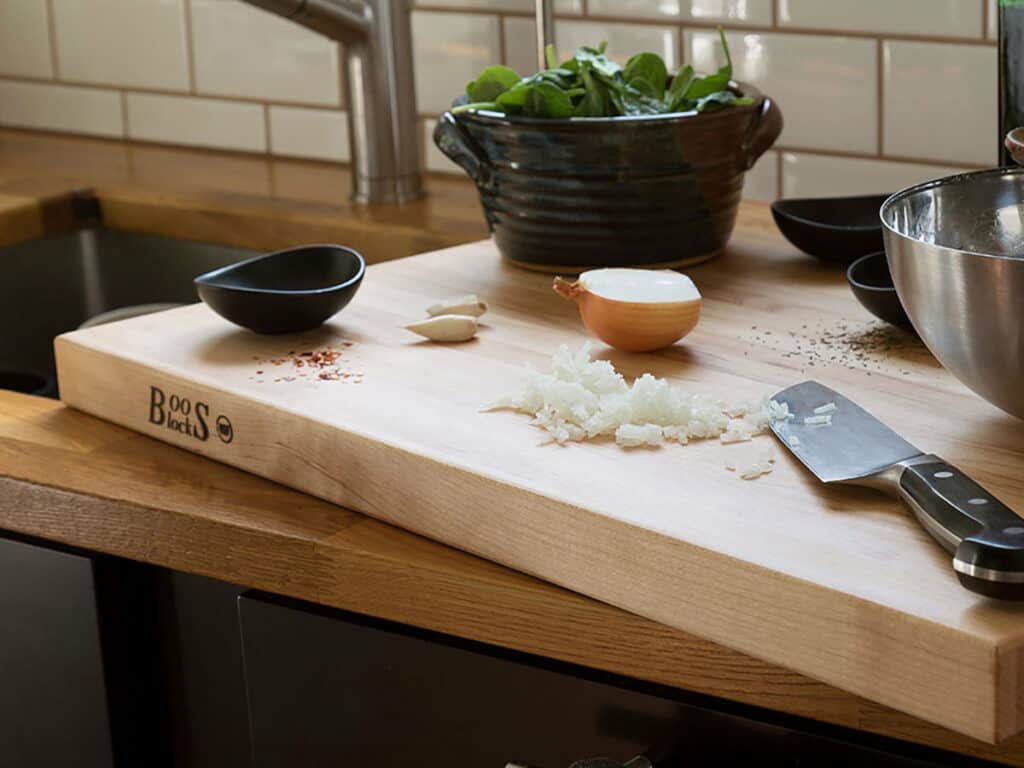
This large 20 x 15-inch maple cutting board is a great option for those with the countertop space to use it.
This maple wood cutting board is large and heavy-duty. Maple is a durable wood, but soft enough that it won’t damage knives. Made in the USA from edge-grain wood, this cutting board is designed for professional use and should last a lifetime with proper care.
Click here to see it on Amazon
Best Edge Grain Cutting Board: TeakHaus
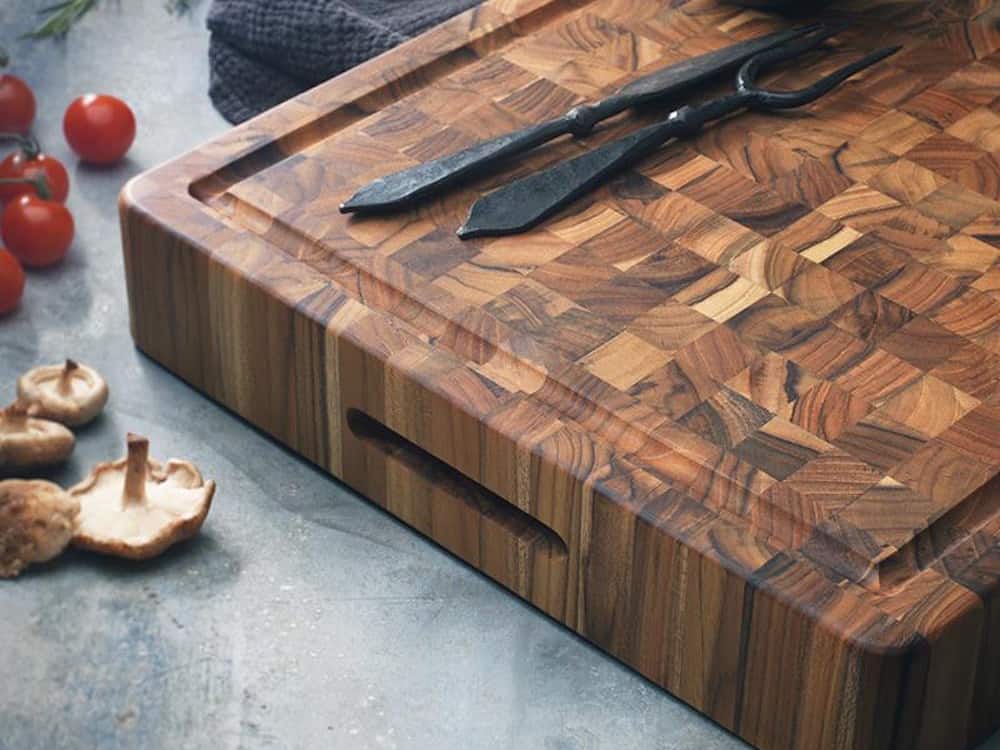
The 15-inch-by-20-inch Teakhaus board is 1.5 inches thick and weighs 12 lbs.
This sustainably-sourced, FSC-certified solid wood cutting board is made from teak. Teak wood is naturally more water-resistant than other types of wood (it’s been used in boatbuilding for thousands of years), making it require less maintenance than other solid wood cutting boards.
This TeakHaus cutting board doesn’t have any non-slip feet on the bottom, but its heavy weight of 12 lbs should keep it from moving around most countertops. If slipping is still a concern, putting a thin wet cloth or paper towel underneath should stop any potential movement.
Every TeakHaus cutting board looks different, making it a unique piece for your kitchen. This cutting board is available with and without a juice reservoir, depending on your needs.
Click here to see it on Amazon
Best Natural Rubber Cutting Board: Yoshihiro Hi-Soft
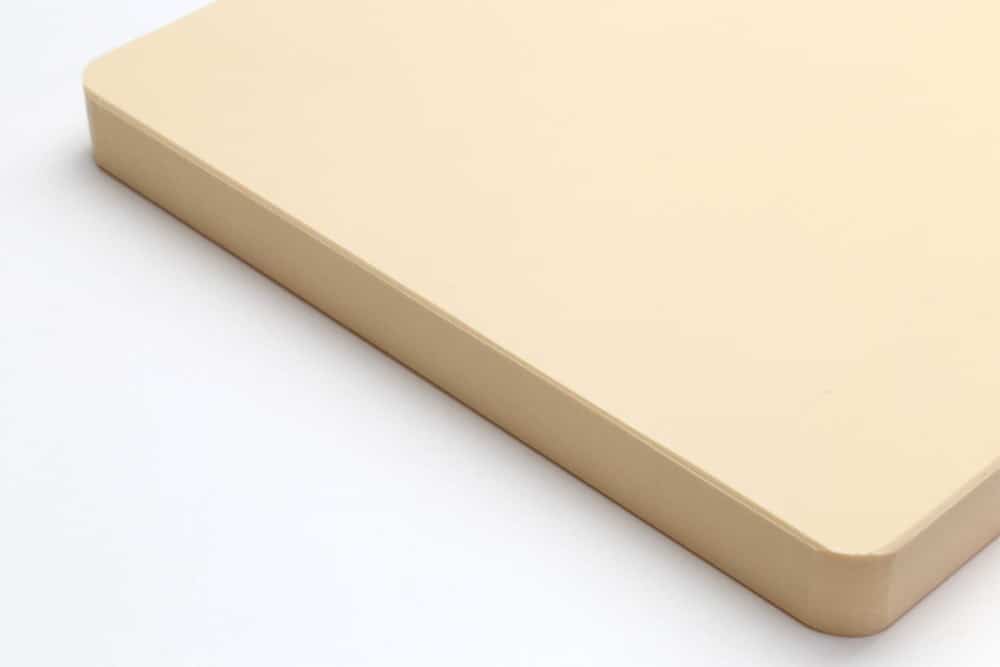
Yoshihiro Hi-Soft natural rubber cutting boards are one of the best non-toxic cutting boards. They are made in Japan from 100% natural rubber, durable, non-slip, and water-resistant.
They’re also BPA-free and phthalate-free, making them a safe food-grade material.
It’s important to note that cutting boards like these are meant for users with high-end knives. It’s crucial to be careful when using a cutting board like this, or damage is likely to happen. The cutting technique used is also critical because the natural rubber surface is susceptible to damage.
Click here to see it on Amazon.
Best Cherry Butcher Block Cutting Board: Brooklyn Butcher Blocks
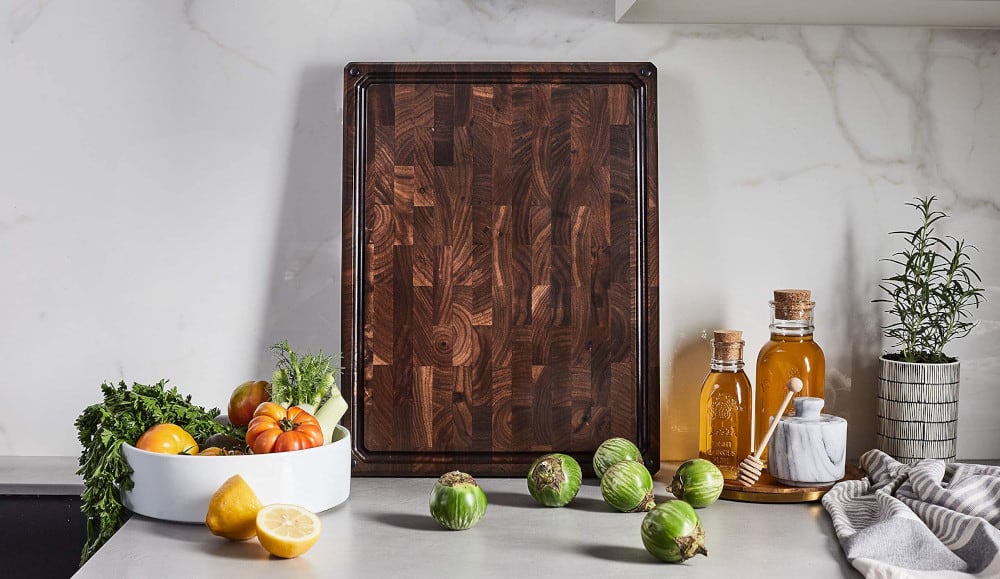
This luxurious solid cherry wood butcher block is sourced from the USA. 90% of materials used in the board are sourced within 400 miles of the manufacturing facility.
From the manufacturer, you can choose between the regular flat block cutting board, or a version with juice groove and handle for an extra $15. The wood feels luxurious but has a nice sheen that’s present even before it’s oiled. The board is heavy-duty and should last years with proper care.
Every Brooklyn Butcher Block is unique, with natural variations in the wood that only add to its beauty.
Click here to see them on the manufacturer’s website.
Best Budget Cutting Board: Ziruma Teak Wood Cutting Board

For the budget-minded shopper, this solid teak wood cutting board just might be the best non-toxic cutting board for you.
It’s made from FSC-certified teak wood and comes in 100% plastic-free packaging.
It comes in four sizes: 14×9″, 17×11″, 20×15″ and 24×18″ depending on your requirements. As a nice bonus, Ziruma includes a container of organic beeswax for treating your new solid wood cutting board.
This cutting board comes to you straight from the factory treated with a mixture of beeswax, linseed, and lemon oils, and avoids potentially toxic coatings like mineral oil.
Judging by user reviews of this cutting board, some people have issues with their board arriving cracked. However, it appears that the brand is quick to rectify any problems like this.
Click here to see it on Amazon.
In Summary
If you’re in the market for a cutting board, any of the boards we’ve recommended would be a great choice. Our top pick is the TeakHaus edge grain cutting board, which is made from sustainably-sourced teak and is FSC-certified.
If you’re looking for a natural rubber cutting board, the Yoshihiro Hi-Soft is our top pick – it’s durable, non-slip, and water-resistant.
The Brooklyn Butcher Blocks are perfect for luxury lovers – these butcher blocks are made from solid cherry wood and are sourced from within 400 miles of the manufacturing facility.
Finally, if you’re on a budget, our best value pick is the Ziruma Teak Wood Cutting Board.


